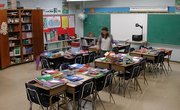"What radical constructivism may suggest to educator's is this: the art of teaching has little to do with the traffic of knowledge, its fundamental purpose must be to foster the art of learning." - Ernst von Glasersfeld
The constructivist theory of education was developed by Lev Vygotsky, a psychologist and educator born in 1896. His theory was centered social constructivism principles. Jerome Bruner later combined Vygotsky’s theories with those of Jean Piaget, a cognitivist who regarded students as learners in their own right that learned through their experiences. Vygotsky's ideas, along with those of Piaget, became widely influential in the 1960s as "child-centered" theory that challenged the more authoritative didactic teaching method previously favored. The constructivist model put forth by Piaget, Vygotsky and Bruner has had reaching implications for contemporary classroom practice.
Constructivist Model Of Working Together
Constuctivist theory approaches to learning assert children have their own way of thinking. Students should be treated as individuals and should have the opportunity to work with others and learn through observation, talking and group work. In the model, students have ideas and skills that have not fully emerged but have the potential to be developed, particularly through this type of interaction with others. Constructivism also acknowledges the importance of social and cultural influences on intellectual development. This, in turn, has an effect on how children learn from each other. Each student brings with him knowledge, opinions and experiences from his individual background that will have an influence on what he brings to the group as a whole.
Active Learning in Constructivist Theory
Constructivists believe students should be engaged in active learning and that the teacher's role is to assist her students in what they are doing. Students should be given the opportunity to explore a problem, try out solutions, build on this new knowledge to make adjustments and evolve new solutions. This learning application in constructivist theory means that all students have an input and are actively discussing and developing ideas. Students must be encouraged to draw, discuss and write about what they are learning. They should also talk to others while actively working and not just sitting in groups.
Scaffolding Learning in Construcvitism
The constructivists suggest as a child learns new things that she should be given lots of support in a process known as educational "scaffolding." This use of constructivism in education can an be done through the use of word banks, writing frames, concrete materials and questioning techniques. Teachers using this learning style provide stimuli and prompts to vary presentation. As the student's learning develops, the scaffolding is gradually removed. The way in which new ideas are introduced and presented to students influences the way in which they are mastered. Instruction in scaffold learning must be structured to be grasped easily while it is presented in a way that involves children's experiences and contexts. Using this learning technique helps build on students' knowledge and willingness to learn.
The Spiral Curriculum
According to the constructivist approach, students’ prior knowledge needs to be developed and built on. Ideas should be reintroduced at different stages and levels in the “spiral curriculum." This then helps to enable a continuous development of knowledge for students. Reintroducing concepts already learned in a "spiral" format helps students to reach a deeper level of understanding. An example of a printable "spiral" would focus on previous math problems with new concepts added into previous ones. In this approach, teachers help students develop and maintain what they already know and use that previous knowledge to solve problems, explore and question. This approach also asserts that teachers must be facilitators of their students’ learning by encouraging and stimulating ideas instead of just transmitting knowledge.
Related Articles
References
Writer Bio
Based in Hampsire in the south of England, Alison Williams has been writing since 1990. Her work has appeared in local magazines such as "Hampshire Today" and "Hampshire the County Magazine." Williams is qualified in newspaper journalism and has a Bachelor of Arts in English language and literature from the Open University. She has recently published her first novel "The Black Hours" and has a master's in creative writing.









